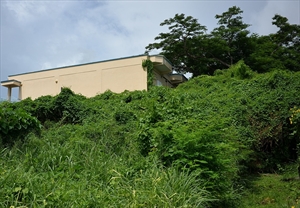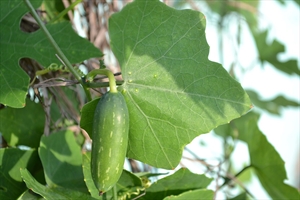- Worldwide distribution. In Australia, Federated States of Micronesia, Fiji, Guam, Marshall Islands, Northern Mariana Islands, Papua New Guinea, Samoa, Solomon Islands, Tonga, Vanuatu.
- Aggressive, fast-growing vine, smothers crops (e.g., sugarcane) and native vegetation, including shrubs, small trees. Common in abandoned gardens, wastelands, roadsides. Environmental weed preventing regeneration of native plants, and impacting diversity. Indirect impacts: host of several important insect pests (cucumber moth, pumpkin beetle, melon fly, aphids, bugs, leafminers, whiteflies).
- Long vines from tuberous roots. Leaves alternate, heart-shaped to 5-lobed, hairy below. Tendrils assist climbing. Separate male and female plants; flowers on stalks up to 5cm, white, five lobes; fruits, smooth, red with brown seeds.
- Spread: tuberous roots and stem pieces; seeds by birds, rodents, possibly pigs. Long distance, medicinal and culinary uses.
- Biosecurity: note, a medicine and a food.
- Biocontrol: stem-boring moth (Melittia oedipus) and leaf-mining beetle (Acythopeus cocciniae) released.
- Cultural control: hand-pulling, removing underground storage roots, collecting and burning stem pieces. Avoid slashing, unless all stem pieces collected.
- Chemical control: in Australia, 2,4-D; 2,4-D + picloram; dicamba; MCPA; triclorpyr; triclorpyr + picloram; triclorpyr + picloram + aminopyralid. Glyphosate, elsewhere.










